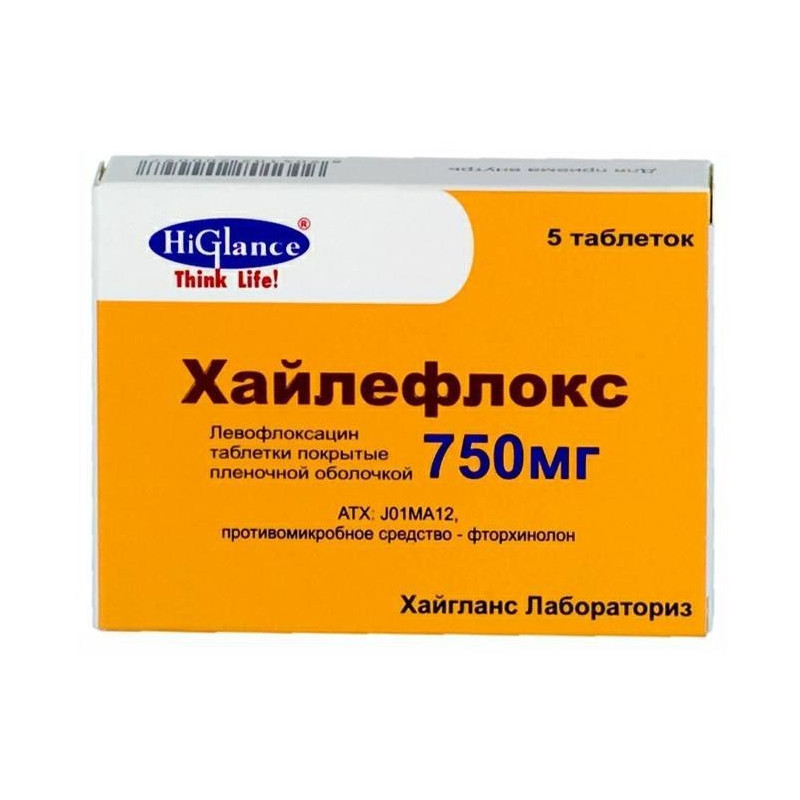



 All payments are encrypted via SSL
All payments are encrypted via SSL
 Full Refund if you haven't received your order
Full Refund if you haven't received your order
Film Coated Tablets
1 tab. contains Levofloxacin 750 mg
5 pieces.
Hileflox has a broad spectrum antibacterial effect.
Carefully - advanced age (high probability of the presence of a concomitant decrease in renal function), deficiency of glucose-6-phosphate dehydrogenase.
Inside before meals or in between meals, without chewing, drinking plenty of water.
Adult patients with normal renal function (Cl creatinine> 50 ml / min) should be used in accordance with the schemes presented in the table:
| Infections | Dose, mg | Frequency of admission per day | Duration of treatment, days |
| Hospital pneumonia | 750 | 1 | 7–14 |
| Community-acquired pneumonia | 500 | 1–2 | 7–14 |
| 750 | 1 | 5 | |
| Exacerbation of chronic bronchitis | 500 | 1 | 7 |
| Acute Bacterial Sinusitis | 500 | 1 | 10–14 |
| 750 | 1 | 5 | |
| Uncomplicated urinary tract infections | 250 | 1 | 3 |
| Complicated urinary tract infections, incl. acute pyelonephritis | 250 | 1 | 10 |
| 750 | 1 | 5 | |
| Uncomplicated infections of the skin and subcutaneous tissues | 500 | 1 | 7–10 |
| Complicated skin and subcutaneous tissue infections | 750 | 1 | 7–14 |
| Chronic bacterial prostatitis | 500 | 1 | 28 |
| Intraabdominal infection (in combination with antibacterial drugs acting on anaerobic microflora) | 500 | 1 | 7–14 |
| Tuberculosis (as part of the complex therapy of drug-resistant forms) | 750 | 1 | Up to 3 months |
Nervous system: headache, dizziness, weakness, drowsiness, insomnia, tremor, anxiety, paresthesia, fear, hallucinations, confusion, depression, movement disorders, convulsions.
Special senses: impaired vision, hearing, smell, taste and tactile sensitivity.
From the CCC: decrease in blood pressure, vascular collapse, tachycardia, prolongation of the QT interval, atrial fibrillation.
Gastrointestinal: nausea, vomiting, diarrhea (including blood), indigestion, loss of appetite, abdominal pain, pseudomembranous colitis; increased activity of hepatic transaminases, hyperbilirubinemia, hepatitis, dysbacteriosis.
Metabolism: hypoglycemia (increased appetite, increased sweating, tremors, nervousness).
Musculoskeletal system: arthralgia, muscular weakness, myalgia, rhabdomyolysis, tendon rupture, tendonitis.
Urogenital: hypercreatininemia, interstitial nephritis, acute renal failure.
From the side of blood-forming organs: eosinophilia, hemolytic anemia, leukopenia, neutropenia, agranulocytosis, thrombocytopenia, pancytopenia, hemorrhages.
Allergic reactions: pruritus and flushing of the skin, edema of the skin and mucous membranes, urticaria, malignant exudative erythema (Stevens-Johnson syndrome), toxic epidermal necrolysis (Lyell's syndrome), bronchospasm, asphyxiation, anaphylactic shock, allergic pneumonitis, vasculitis.
Other: photosensitization, asthenia, exacerbation of porphyria, persistent fever, development of superinfection.
After normalization of body temperature, it is recommended to continue treatment for at least 48–72 hours. Levofloxacin is taken at least 2 hours before or 2 hours after taking Magnesium / aluminum antacids or sucralfate, or other drugs containing Calcium, iron or zinc.Due to the possible photosensitivity during the treatment period and for 5 days after the end of the treatment with levofloxacin, it is necessary to avoid solar and artificial UV irradiation. With the development of phototoxicity drug treatment should be discontinued. When signs of tendinitis and pseudomembranous colitis appear, levofloxacin is immediately canceled. It should be borne in mind that in patients with a history of brain damage (stroke, severe injury), seizures may develop. If glucose-6-phosphate dehydrogenase is deficient, the risk of hemolytic reactions is possible. In patients with diabetes mellitus during treatment with levofloxacin, blood glucose levels should be carefully monitored. With the simultaneous use of levofloxacin and Warfarin, monitoring of PT, INR or other anticoagulation tests is shown, as well as monitoring of signs of bleeding. While taking levofloxacin, the patient's ability to concentrate and the speed of psychomotor reactions may be impaired. In this regard, care must be taken when driving vehicles and engaging in other potentially hazardous activities.
Levofloxacin increases the half-life of cyclosporine. The effect of levofloxacin is reduced by drugs that suppress intestinal motility, sucralfate, aluminum- or magnesium-containing anti-acid drugs and iron preparations. NSAIDs and theophylline with simultaneous use with levofloxacin increase the risk of seizures in susceptible patients, and GCS increases the risk of tendon rupture.While taking levofloxacin with hypoglycemic drugs, changes in blood glucose levels, including hyperglycemia and hypoglycemia, are possible. Levofloxacin enhances the effect of warfarin. Cimetidine and drugs blocking tubular secretion, slow down the elimination of levofloxacin.
Symptoms:nausea, erosive lesions of the mucous membranes of the gastrointestinal tract, prolongation of the QT interval, confusion, dizziness, convulsions.
Treatment:gastric lavage, if necessary - symptomatic therapy. There is no specific antidote, dialysis is not effective.
In a dry, dark place at a temperature of 8-25 ° C.
